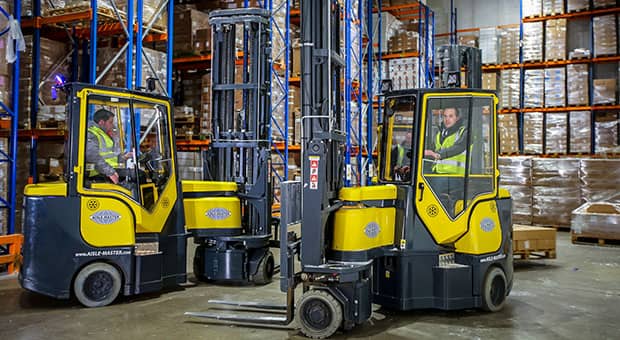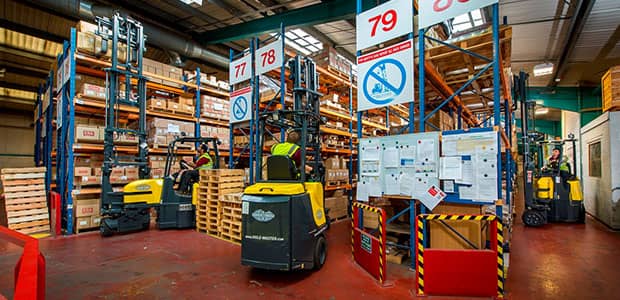Not Sure What Narrow-Aisle Forklift is Right for You?
Contact our team of experts today!
With e-commerce becoming a dominant force, warehouses and distribution centers are faced with the need to improve their efficiency in the supply chain. This means that more product needs to be stored and moved in a quick and streamlined way. Traditional warehouse facilities and distribution centers are met with the growing need to store more products and utilize the storage space most effectively. To have machines that can not only fit through the tight aisles but perform with the same capacity is key for the new age storage facilities. Narrow aisle forklifts are specially designed for the tight aisles of the warehouse or distribution center to lift and stack the pallets more productively. By Investing in narrow aisle forklifts, warehouses can maximize their storage capacity by decreasing the width between aisles and reclaim up to 60% of usable floor space in a facility.

Contact our team of experts today!

Narrow aisle forklifts are designed to operate in work areas with limited space because of their tighter turning radius and enhanced maneuverability. Other key features of a narrow aisle forklift include:
Lead-Acid Batteries
Lead-acid batteries are the common source of power used in electric forklifts. These traditional batteries offer optimum power for most makes and models of forklifts and serve as a counterweight to balance the
load on narrow aisle forklifts. This is a great advantage as narrow aisle forklifts do not have bulky frames to maintain the center of gravity while carrying loads. Lead-acid batteries are suitable for applications running forklifts for 3-5 days a
week.
Lithium-Ion & Lithium-Iron Phosphate Batteries
Lithium batteries are the recent innovation in optimal and long-lasting power sources. These are more expensive than lead-acid batteries but offer a longer life span and enhanced
safety. Lithium batteries come with faster charge times and reduced maintenance costs and require minimal charging space which adds value for warehouse operations looking to save on space. The lithium-ion battery option is most suitable for applications
that demand longer running hours as these have a higher upfront cost. These batteries are similar to those found in electronic devices like your cell phone. Unlike lead-acid batteries, these are completely sealed and do not require maintenance like
watering.
We carry a large selection of narrow aisle forklifts from world-class manufacturers such as Jungheinrich, Hyundai and Aisle Master. Our narrow aisle forklift lineup carries a variety of sit-down, VNA and compact design options. Finding the right machine for your application can be daunting, our sales team can help you pick out the best forklift for your application.
Picking the right forklift for your business can help you make the most of these benefits. A suitable piece of equipment can be a defining factor in creating a smarter, safer, and more efficient workplace. This can be achieved with a redesigned warehouse space that includes proper dimensional data and a pallet racking system to introduce the appropriate equipment. It is important to have the exact information about the aisle width and the racking height for the amount and type of product that will be stored. This information will help to pick the right type of machines to move and store the product. Involving a sales representative from your machine provider is essential when considering the process of redesigning your warehouse to integrate the best material handling solutions into the system. A warehouse designed around these aspects can increase inventory velocity by up to 360%.
Increased storage space
Using narrow aisle forklifts in warehouses or distribution facilities can increase usable floor space by up to 60%. This can be achieved by adding more racks in the space saved by using narrow aisle lift trucks instead of bulky traditional forklifts.
Easy navigation
Narrow aisle forklifts are specialized to navigate easily in the constricted aisle spaces. Some of the narrow aisle lift trucks are equipped with articulating forks making it easier to access the racks for the operators.
Improved handling
Along with easy navigation, these forklifts allow improved handling for operators as they are less cumbersome to operate and much easier to learn for beginners.
Safety
There will always be some risk associated with operating a larger forklift in a narrow aisle space as it limits the operator's view and can require multiple 3-point turns. Using a narrow aisle forklift mitigates the risk of product damage and injuries.
Cost-effective
Narrow aisle forklifts can lower a company’s overall costs when you consider maximization of the space. Companies no longer need a larger warehouse, just a more efficient one. In addition, some of these units can enter transport vehicles, replacing the need of two lift trucks.
So even if investing in narrow aisle forklifts may seem like a big upfront cost, it is worth considering it.
Narrow aisle forklifts are classified as class II under the forklift classification as per Occupational Health and Safety Administration (OSHA). These electric motor narrow aisle lift trucks are primarily used in storage facilities and fulfillment centers. The main purpose of a narrow aisle lift truck or forklift is to move the inventory in a typical warehouse layout. However, businesses can have unique warehouse management systems that demand different types of forklift configurations to align with their needs. Fortunately, narrow aisle forklifts come in a range of configurations that can work seamlessly with warehouse management systems.
Reach trucks
Reach trucks as the name suggests are used to reach into the racks to pick up the pallets. These lift trucks have double the reach capacity but need the widest aisle space of all narrow aisle lift trucks. These forklifts can be used in warehouses with first in first out (FIFO) or first in last out (FILO) system due to their impressive reach capacity. Reach trucks can lift 4000 lbs. with a maximum height of 25 ft. The lift and height capacity may vary for different makes and models.
Articulated Forklifts
Narrow aisle articulated forklifts such as Aisle Master models need less aisle space to lift loads of the same capacity. These forklifts are equipped to maneuver in aisle spaces as small as 63 inches.
Turret trucks
Turret trucks are often referred to as very narrow aisle forklifts. These lift trucks come with an articulating carriage that can be rotated to 180 degrees. This allows the trucks to occupy minimal space while moving inventory. Turret trucks are mainly used for lifting longer loads without needing any additional manpower to double handle the load. They do however need a guidance system to move through the aisles which adds to the overall cost.
Order picker
Order pickers are mostly used in warehouses for order fulfillment. Designed to operate at heights, order pickers can reach up to 390” and have a tight turning radius of 65”. Operators are harnessed to the machine while being elevated to pick the inventory and place it on the skid. Order pickers can hold up to 3000lbs and are highly efficient for picking large quantities of multiple SKU’s safely.
The most recent innovation in warehouse management systems is the introduction of auto-guided vehicles (AGV). These automated or driverless forklifts will be game-changing in the distribution and e-commerce industries. These robotic forklifts have a virtual layout of the warehouse stored in the system. The auto-guided forklifts use this layout to navigate through the aisles with the help of a sensor-based guidance system. The automated forklifts use the SKU number and information stored in the system for picking up pallets without an operator.